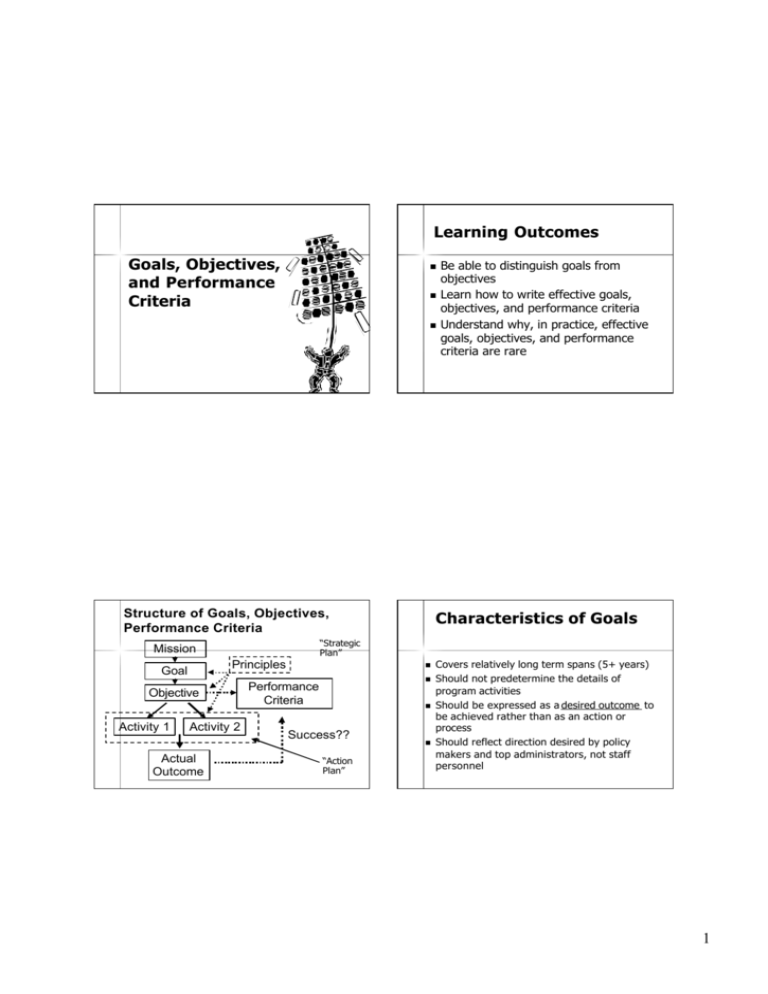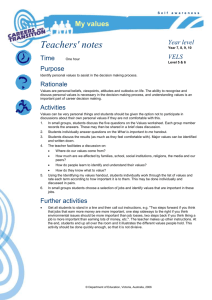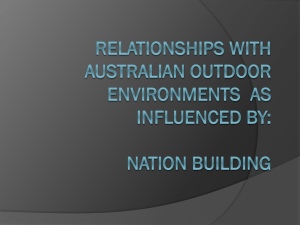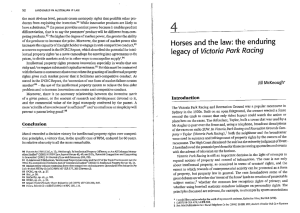Goals, Objectives, and Performance Criteria Learning Outcomes
advertisement

Learning Outcomes Goals, Objectives, and Performance Criteria n n n Structure of Goals, Objectives, Performance Criteria Principles Goal Objective Activity 1 Activity 2 Actual Outcome Characteristics of Goals “Strategic Plan” Mission n n Performance Criteria n Success?? “Action Plan” Be able to distinguish goals from objectives Learn how to write effective goals, objectives, and performance criteria Understand why, in practice, effective goals, objectives, and performance criteria are rare n Covers relatively long term spans (5+ years) Should not predetermine the details of program activities Should be expressed as a desired outcome to be achieved rather than as an action or process Should reflect direction desired by policy makers and top administrators, not staff personnel 1 Characteristics of Objectives n n n n n Characteristics of Performance Criteria More difficult to formulate than goals Derived from goals; an objective must be accomplished to achieve a goal; some goals will require more than one objective Should be expressed as a desired outcome rather than as an action or process Should account for unintended or negative effects Lower level program personnel are source of knowledge for defining objectives n n n n n Goals vs. Objectives Basis of Comparison Similar Different Desirable Characteristics of Actions or Activities Characteristics Goals Terminology clearly defined Objectives Terminology clearly defined Outcome oriented Not measurable in quantitative terms Partially operational Time period unspecified Outcome oriented Measurable in quantitative terms Fully operational Time period specified Are explicit part of objectives Should be based on specific performance targets Should be objective (verifiable by outside sources) Should indicate degrees of accomplishment Should be agreed to by major actors involved in the program—managers, supervisors, field personnel n n Linked to problems Linked to problem characteristic of larger areas characteristic of specific area Broad purposes Specific aims n Developed at highest levels Developed at intermediate within policy structures and lower levels within policy structures n always be linked to specific objectives should be focused on process (tells who, what, where, when and how) should be feasible based on available resources and constraints should be appropriate within the local context 2 Alpine Resorts Tourism Business Plan 2003 -2006 (Victoria, Australia) Vision: To effectively position Victoria’s alpine resorts as Australia’s leading alpine destination over the next four years. Objectives • Develop and implement effective and timely co -operative marketing and communication initiatives which focus on growing the snow market for the overall benefit of the Victorian alpine industry by targeting market seg ments with the highest growth potential. • Improve customer perception of the snow experience. • Deliver high quality products in the region that meet contemporary customer wants, needs and expectations. • Undertake key research initiatives to assist in improving product development and delivery, and the effectiveness of marketing initiatives. • Increase the opportunities for, and awareness of, holidays in Victoria’s alpine region throughout the year. • Ensure Victoria’s alpine tourism industry is sustainable in the longer term. • Enhance communication between stakeholders and increase awaren ess of co operative product development and marketing initiatives. Victoria’s Racing Tourism Plan 2005-2007 Objective: Generate tourism benefits for Victoria from Thoroughbred Racing business events. Strategy Identify opportunities to leverage off existing non racing business events held in Melbourne and regional Victoria. Action. Brief relevant organisationson racing product that could be included as pre and post touring options or scheduled activities. Objective: Generate tourism benefits for Victoria from Greyhound Racing business events. Strategy Increase the national and international profile of Victoria's greyhound racing industry via business events. Action Develop a calendar of national and international business events relevant to greyhound racing. Hawaii Tourism Strategic Plan 2005-2015 GOAL To maintain and improve transportation access, infrastructure and services to facilitate travel to, from and within Hawaii OBJECTIVES • Ensure adequate lift to Hawaii. • Improve inter-island transportation services. • Improve airports and supporting systems. • Improve harbors and supporting systems. • Improve roads, highways and ground transportation systems. • Ensure safe passage for residents and visitors. • Expedite processing of visas. • Encourage coordination, collaboration and improved ground tran sportation services. Measures of Success: Specific to issues related to access, the following measurements provide an indication of success: • Increased scheduled flights to and within Hawaii during should er seasons • Updated and coordinated State and county master plans for airp orts, harbors and highways • Faster check -in, customs and immigration, and security processing times at airports and harbors • Decreased congestion in airports and harbors • Decreased traffic congestion on roadways • Increased visitor satisfaction with airports and ground transportation • Fewer visitor complaints about airports and ground transportation Sample Goals, Objectives, and PC from Land and Survey Department Goal: To speed up the issue of mining leases and prospecting licenses so that the State’s mineral resources can be fully exploited to benefit the people and the State Relabeled as a goal.... Unneccessary condition… Objective: Increase the area land (in hectares) leased for mining by Objective: Increase the number of mining leases issued 10% in fiscal year 2004. by 10% in fiscal year 2004. Performance criteria: Hectares of Performance criteria: Number land leased for mining in 2004. of mining leases issued in 2004. Action: Revise mineral leasing Action: Increase minimum amount approval criteria by eliminating of land for lease applications. xxxxxxx criteria. 3 Sample Goals, Objectives, and PC National Parks and Wildlife Division Potential Revision Original Objective: To develop an effective publicity and extension service on nature conservation Not an objective… Focused on action, not outcome… Goal: To increase public commitment to nature conservation in Sarawak. Objective: Increase the number of Sarawak households that visit nature reserves and national parks by 10% in 2004. Performance criteria: Number of households that visit nature reserves and national parks in 2004. Action: Develop media adds to appear on TV, radio, and newspapers in 2004. Goals from “The National Greenhouse Strategy” (1998) 1. To limit net greenhouse gas emissions, in particular, to meet our international commitments. 2. To foster knowledge and understanding of greenhouse issues. 3. To lay the foundations for adaptation to climate change. Performance indicators will be employed to contribute to assessments of the effectiveness of the NGS. “As a result of the Kyoto Protocol, developed countries, as a whole, will strive to reduce their greenhouse gas emission s from 1990 levels by at least five per cent by 2008–2012. In recognition of the fact that developed countries have different economic circumstances and differing capacities and costs in making emissions reductions, each developed country has a specific, differentiated target. Australia’s requirement is to limit our greenhouse gas emissions in the target period to no more than eight percent above 1990 levels.” Objectives from “National Strategy for the Conservation of Australia’s Biological Diversity” (1996) 1.1 Identify important biological diversity components and threatening processes. 1.2 Manage biological diversity on a regional basis, using natur al boundaries to facilitate the integration of conservation and production- oriented management. 1.3 Improve the standards of management and protection of Australia's biological diversity by encouraging the implementation of integrated manage ment techniques. 1.4 Establish and manage a comprehensive, adequate and represent ative system of protected areas covering Australia's biological diversity. 1.5 Strengthen off-reserve conservation of biological diversity. 1.6 Ensure the maintenance of, and where necessary strengthen, existing arrangements to conserve Australia's native wildlife. 1.7 Enable Australia's species and ecological communities threatened with extinction to survive and thrive in their natural habitats and to retain their genetic diversity and potential for evolutionary development, an d prevent additional species and ecological communities from becoming thre atened. 1.8 Recognise and ensure the continuity of the contribution of the ethnobiological knowledge of Australia's indigenous peoples to the conservation of Australia's biological diversity. 1.9 To complement in-situ measures, establish and maintain facilities for ex -situ research into and conservation of plants, animals and microorganisms, particularly those identified by action taken in accordance withObjective 1.1. If you don’t specify your target, how do you know whether you’ve hit it? If you don’t indicate where you are going, how do you know if you got there? 4 Reasons for Not Developing Specific Goals, Objectives, and Performance Measures? n n n n n Difficult/ambiguous Time consuming Creates accountability Implies resource allocation and perhaps changes in allocation Creates political target Problems with Goals in Practice n n n They often conflict!!!! …and seldom is guidance provided to resolve conflicts based on prioritization or weighting of goals They are ambiguous …and without objectives to provide clarity, they become a highly subjective guide to action They ignore real-world trade-offs …and often reflect wishful thinking rather than difficult prioritization and allocation of scarce resources 5








